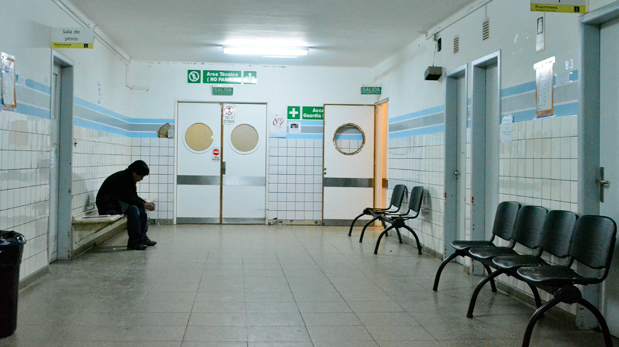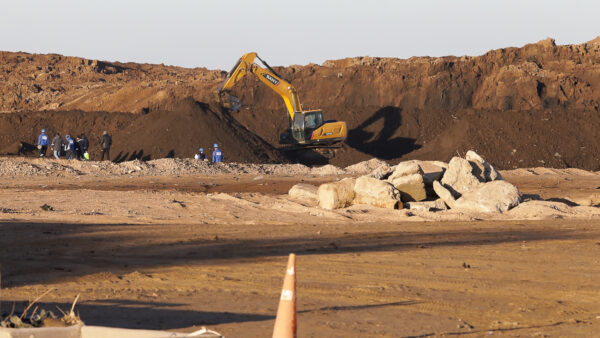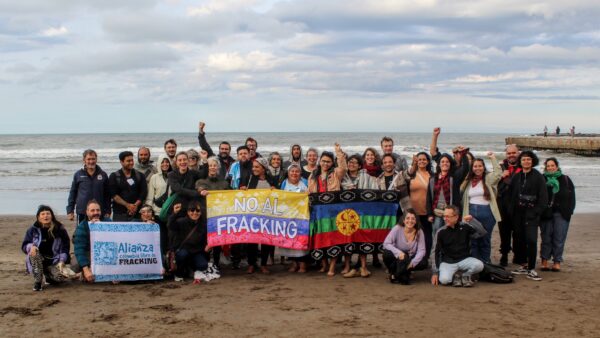The lack of research to support the widespread perception that the prevalence of different types of cancer is greater in oil towns than in the rest of the country makes these societies territories of uncertainty. Based on testimonies of health professionals from Caleta Olivia and Comodoro Rivadavia, we inquire about the absence of such studies, the consequences associated, and the capacity of the public and private systems to provide care to those who need it. Statistics are missing but patients are not.

by Hernán Scandizzo / OPSur
Comodoro Rivadavia and Caleta Olivia are two pieces of the same puzzle: The Golfo San Jorge basin. The south of Chubut and the north of Santa Cruz are united by a common history –hydrocarbons extraction–, which began in 1907. A century later, driven by exploration and exploitation concessions, it branched out into land and sea over more than 60,000 square kilometers. As it is the case in other communities of the country where certain extractive activities or industrial processes are carried out, the population of both cities affirms that some pathologies are more prevalent there than in the rest of Argentina. The lack of statistics and research to confirm that perception makes these societies territories of uncertainty. In such a context, the public health system, crippled by overwhelming needs, faces the situation squarely. While it is true that thorough studies confirming suspicions are still needed, the patients are still there. Meanwhile, far from bridging the existing gaps, private health plans and health insurance funds increase the burden.
“There are no statistics, either private nor governmental, but there is a very striking number of patients with different types of cancers. We do not know why there is so much prevalence, if it is the case that it has actually increased,” says Néstor Sosa, a surgeon at the local Hospital Zonal in Caleta Olivia and Assistant Secretary of the local branch of the Asociación de Trabajadores del Estado (State Workers Association). “If there are no statistics, you do not know what the problem is, you do not know how big the problem is, you will not be able to solve it,” he warns, and completes the thought: “In fact there is a policy of quasi negation, because you do not see important gestures. For example, the Northern area [of the province of Santa Cruz] has one oncologist; thus the ability to solve the problem is very limited.”
“I know there are a lot of cases of breast, , lung, and especially rectum and colon cancer, that’s what you see frequently when you visit oncology wards,” says Sosa. And he goes back to the previous statement: “There may be many factors in common, but problems are mostly attributed to water, without having a scientific basis. There is no serious study that denies or confirms it.” It also draws attention to a large number of children with developmental disorders, learning impairment, and lower IQs. The conclusion is similar: “You see a rather alarming number of children, which surpasses the average one would expect; I think that the studies are not thorough enough to determine an etiological cause.” The words clash against the microphone of the tape recorder; the interview takes place in the empty cafeteria of a gas station. It is Sunday night, the ever-present TV broadcasts a football match played more than 1,800 kilometers north of that table, in a Buenos Aires neighborhood.
The surgeon´s testimony match the statements of Mara Marquez, chief of pediatrics at the Regional Hospital of Comodoro Rivadavia. “We have a high incidence of tumor pathology and leukemia; unfortunately, truth is they are not treated here. They are referred to other facilities, due to lack of resources, since we do not have a pediatric hematologist-oncologist”, he states. “We have the impression, without statistics because we do not have them, that there is an increase of oncological pathologies compared to other places,” he emphasizes. Shortages once again open the way to uncertainty. “I cannot tell you if what’s going on it’s because of oil, if it’s enzymatic disrupters, because there is no serious study carried out.” The only certainty is what is missing. . She immediately emphasizes: “But we noticed that there is a high incidence compared to other places.”
Public hospital, private burden
“Speaking subjectively,” says Márquez, “four years ago, and may be more, five or six, we began to see an incidence of these pathologies. There are more cases of leukemia and solid tumors, but that may be because more people is receiving attention at the Hospital, given that the private centers of Comodoro do not hospitalize serious patients, and five years ago, they closed the pediatric guards,” he explains. He stresses once again the importance of statistics, since uncertainties could be solved with scientific studies.
Márquez claims that the Public Health System in Comodoro Rivadavia “ended up being too small”. “But why? Not because there are more Bolivian, Paraguayan immigrants but because we are attending patients with private health insurance plans like SwissMedical, OSDE, Docthos, the best prepaid medicine and medical insurances companies. If the son of the richest person in Comodoro Rivadavia is injured, he comes to our intensive care unit,” says the head of Pediatrics at the Regional Public Hospital of the town. The interview takes place in a hall, from the hallway come the testimonies embodied in the constant movement seen in the pediatrics ward.
Again, the testimony of Marquez and Sosa come together. “The private sector is not able to see the patients because it has no specialists in the area. They can treat complications in cancer patients: a cancer patient with pneumonia, for example; but the underlying disease, the cancer treatment, chemotherapy and radiation, they cannot do it,” says Néstor Sosa, with regards to medical services in the north of Santa Cruz. “For a time the government’s policy tried to undermine the private sector, with the aim of strengthening the public sector. They were never able to strengthen the public sector, but they succeeded in undermining the private sector. Thus, with money or without money, the possibility of excellence in health care is very difficult to find here.”
Accessibility and distance
“What’s the fate of a cancer patient in Caleta Olivia?” Sosa asks. And he answers: “It’s problematic. There is only one oncologist who treats patients at the local Hospital Zonal, which, of course, has its breaks. Suddenly she has her holidays, she has an illness, she has her stuff. And she does not have a replacement during those breaks, and there remains a very small capacity of treating people. ” He makes a short pause, and explains further: “The doctor in charge of the oncology ward has more than a thousand patients on the list, not only here, but also from inland in the province. Patients whose doctor is far away, more than 300 kilometers.” At this point in his story he clarifies that they come from Los Antiguos, Perito Moreno, Las Heras, Pico Truncado, Firtz Roy, Jaramillo, Puerto Deseado and even, underlines the doctor, San Julián .
In the absence of statistics, it cannot be established whether in the oil city of Las Heras, the pathology is more prevalent than in Puerto Deseado, for example. “We only have the number of patients who go to a clinic solving the pathology of the moment,” Sosa says. In cases of leukemia or lymphomas, which are oncohematologic pathologies, the Caleta Olivia Hospital has no hematologist, and the person must go “to Comodoro, Buenos Aires or elsewhere.” “There is no possibility of being treated here.” And he continues enumerating the shortages, as if going through the rosary beads.” There is no radiotherapy in Santa Cruz, you have to do it in the nearest province [Chubut], which means that half of the treatment is not covered. A patient who has to receive radiation for a brain metastasis, who lives in Los Antiguos, around 400 kilometers away, has to stay alone a month or more in God-knows-where, to be able to do the treatment. The lack of accessibility is a very serious problem here.”
Statistics and neglect
“We know, to begin with, that our province [Chubut] has higher rates of cancer than others,” says general practitioner Susana Muñoz, a professor and coordinator of the Higher Technical Qualification in Community Health Sciences. “This has been happening for a long time, but a more thorough epidemiological research is not taking place. In addition, you cannot bundle all types of cancer together, there are some that are specific to certain environmental risks,” she clarified. Outside, the leaden sky and the intense cold intensify the winter. In contrast,the atmosphere in the office is warm, and the talk flows uninterrupted.
“The information is disaggregated into types of cancer, but we do not know if it is the whole the information,” she says. And then she introduces a series of variables that should be taken into account: “Many people from Comodoro are not treated here, but in other places, they travel. We do have other people that are treated here. We have people coming from different areas in the province, who are treated in the CABIN [Bionuclear Applications Center], which is an area for radiation therapy”. The information is too disorganized, so it is very difficult to differentiate properly. Because it needs a certain permanence during a certain time,” she explains.
“Unfortunately there are few [epidemiological] studies [in Argentina] on environmental problems, and environment and non-communicable diseases, such as cancer or other types of hemato-oncological diseases, serious and pernicious cases of anemia. There is a lot of information about the health impacts caused by certain environmental pollutants derived from oil. It is well studied internationally, but there is a great deficit of local epidemiological studies, those that can demonstrate health harms on that are caused by certain environmental situations,” explains the general practitioner. “Comodoro is in an almost ideal situation to do that, there are important sectors of the population that could be studied, that have been in contact with such situations, that still are, because they live in areas where there were oil wells or because they work in contact with them. There are many conditions, but there have been no developments,” she regrets.
“There are many factors that make the analysis more difficult,” she warns, but “it can still be done because it has been done in many parts of the world.” Why not here? “It is not only because of the political or economic interests of oil companies, which I am sure they exist.” She immediately adds another factor, which makes more complex what at first seemed linear: “A lot of it has to do with the neglect in the functioning of our State for many decades, with a lack of continuity in public policies.”
Muñoz illustrates it with a simple example: “A national system of injury surveillance was organized: assault, self-harm (suicide), in different ways. When [people] get to the ER, the record states ‘injuries’, and that hides a lot of problems that lie behind.” “A template was designed to fill in when an injured patient arrives, to get more information about the actual causes. It was distributed to all the ERs in the country,” she pauses. “Almost all the hospitals that began to fill it –all of them in this province, and in other places almost all– stopped doing it. It could not be sustained in time, for whatever reason. It was a very important source of information and a simple procedure to follow. Let alone with cancer, which is much more complex, because it is multifactorial, there are many more elements that should be taken into account to be able to see to what factors the person was exposed,” she concludes.
* This article is part of the series On water and oil, questions about the present of the San Jorge Gulf basin.
Source http://opsur.org.ar/2017/07/26/cuenca-del-golfo-san-jorge-cancer-en-un-territorio-de-incertidumbre/




